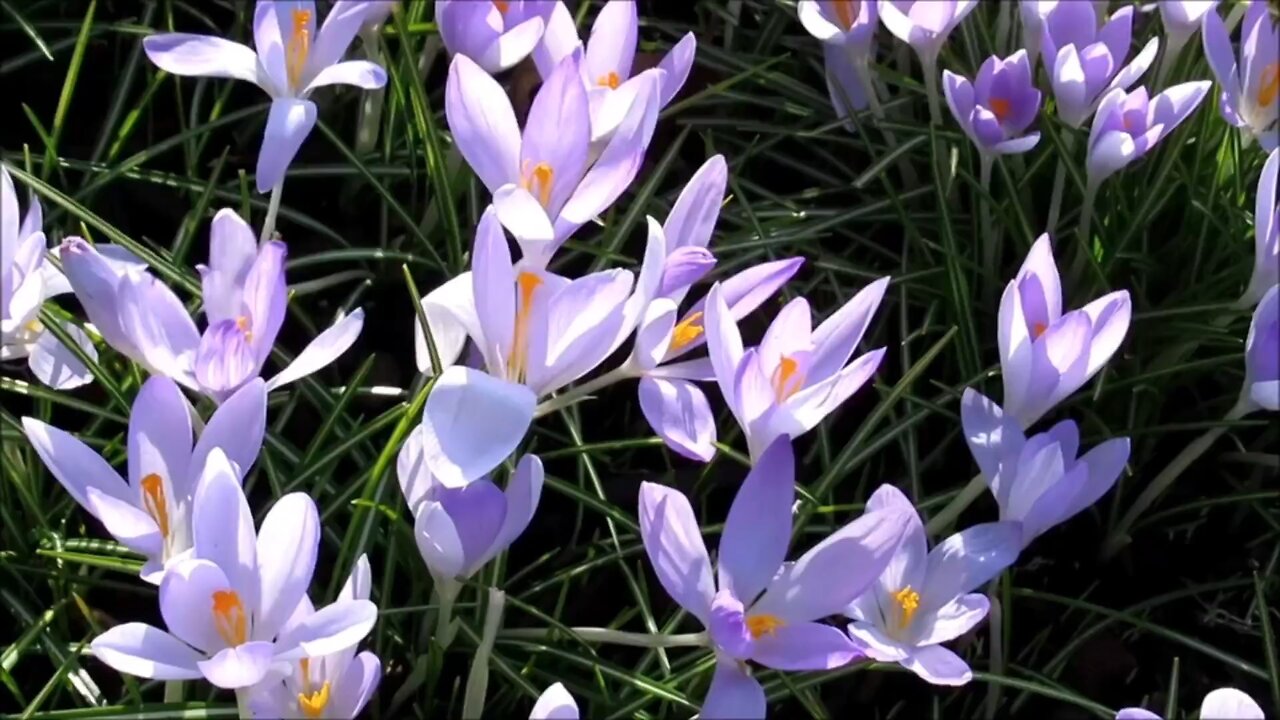Premium Only Content

"Autumn Blooms: The Magic of Crocuses"
(*Crocus speciosus* or similar species). Crocuses are small, cup-shaped flowers that are part of the Iris family (*Iridaceae*). Here’s a detailed look at crocuses:
### **Botanical Classification**
- **Family:** Iridaceae
- **Genus:** *Crocus*
- **Common Names:** Crocus, saffron crocus (for certain species), autumn crocus
### **Physical Description**
- **Flowers:** Crocuses produce delicate, goblet-shaped flowers with six petals (three outer petals and three inner petals). They can be found in various colors, including purple, lilac, yellow, white, and even striped varieties. The flower's central stigma is often orange or yellow, adding a contrasting color to the flower’s palette.
- **Leaves:** The leaves of crocuses are narrow, grass-like, and typically have a silvery-white stripe running down the center.
- **Height:** Crocus plants are generally low-growing, ranging from 3 to 6 inches in height.
### **Habitat and Distribution**
- Crocuses are native to regions across Europe, North Africa, and Asia. They thrive in well-drained soils and prefer sunny or partially shaded locations. They are often found in alpine regions, meadows, and woodlands.
- Crocuses are hardy plants that can withstand cold temperatures, making them popular in temperate climates.
### **Flowering Season**
- **Spring Crocus:** Most crocus species bloom in early spring, often poking through the last snows of winter, making them one of the first signs of the changing season.
- **Autumn Crocus:** Some species, like *Crocus speciosus*, bloom in the fall, typically from September to November, after the leaves of the plants have died back.
### **Ecological Role**
- **Pollinator Support:** Crocuses are vital for early-season pollinators, such as bees, as they provide nectar and pollen when few other plants are in bloom.
- **Naturalization:** Crocuses can naturalize in lawns, borders, and rock gardens, spreading over time to create colorful carpets of flowers.
### **Cultivation and Care**
- **Planting:** Crocuses are usually grown from corms, which should be planted in the fall for spring bloomers and in late summer for autumn bloomers. They prefer well-drained soil and can tolerate both full sun and partial shade.
- **Watering:** Crocuses require regular watering during their growing season but prefer drier conditions once they go dormant.
- **Propagation:** Crocuses can be propagated by dividing the corms after the foliage has died back. This can help maintain their vigor and prevent overcrowding.
### **Cultural Significance**
- **Symbolism:** Crocuses are often associated with youth, cheerfulness, and the joy of spring. In some cultures, they symbolize hope and renewal.
- **Use in Gardens:** Crocuses are popular in rock gardens, under trees, and in lawns, where they can be left to naturalize. Their early blooms make them a favorite among gardeners looking to add color to their landscape after winter.
### **Pests and Diseases**
- **Common Issues:** Crocuses are generally pest-resistant, though they can be susceptible to bulb rot if planted in poorly drained soil. Squirrels and other rodents may dig up and eat the corms.
Crocuses are cherished for their early or late-season blooms and their ability to add vibrant color to gardens when few other plants are in flower. Their easy care and naturalizing habits make them a favorite for gardeners looking to create long-lasting floral displays.
-
 29:54
29:54
Michael Franzese
10 hours agoCan Trump accomplish everything he promised? Piers Morgan Article Breakdown
96.8K49 -
 2:08:19
2:08:19
Tactical Advisor
14 hours agoThe Vault Room Podcast 006 | Farwell 2024 New Plans for 2025
173K11 -
 34:12
34:12
inspirePlay
1 day ago $5.09 earned🏆 The Grid Championship 2024 – Cass Meyer vs. Kelly Rudney | Epic Battle for Long Drive Glory!
75.9K8 -
 17:50
17:50
BlackDiamondGunsandGear
12 hours ago $1.91 earnedTeach Me How to Build an AR-15
50.7K6 -
 9:11
9:11
Space Ice
1 day agoFatman - Greatest Santa Claus Fighting Hitmen Movie Of Mel Gibson's Career - Best Movie Ever
110K45 -
 42:38
42:38
Brewzle
1 day agoI Spent Too Much Money Bourbon Hunting In Kentucky
74K12 -
 1:15:30
1:15:30
World Nomac
20 hours agoMY FIRST DAY BACK in Manila Philippines 🇵🇭
57K9 -
 13:19
13:19
Dr David Jockers
1 day ago $10.86 earned5 Dangerous Food Ingredients That Drive Inflammation
76.5K17 -
 1:05:13
1:05:13
FamilyFriendlyGaming
1 day ago $15.76 earnedCat Quest III Episode 8
129K3 -
 10:39
10:39
Cooking with Gruel
2 days agoMastering a Succulent London Broil
82.8K5